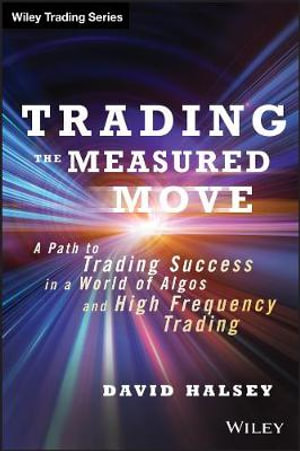 David Halsey throws out the old notion of a measured move: that you copy an AB move up (or down) and paste it on a retracement low (or high) of C to get your price target D. In Trading the Measured Move: A Path to Trading Success in a World of Algos and High Frequency Trading(Wiley, 2014) he substitutes Fibonacci levels.
David Halsey throws out the old notion of a measured move: that you copy an AB move up (or down) and paste it on a retracement low (or high) of C to get your price target D. In Trading the Measured Move: A Path to Trading Success in a World of Algos and High Frequency Trading(Wiley, 2014) he substitutes Fibonacci levels.
He uses three trade setups: the traditional 50% retracement measured move (MM), the extension 50% MM, and the 61.8% failure. When a trade is entered, its target is 123% from a swing high or low (and sometimes from a breakout) that is followed by a retracement (50% in the traditional setup). That is, the target is AB + 23%. Halsey shows both successful and failed MM trades on charts—unfortunately usually grey bars on a black background, which makes them hard to decipher.
The measured move trade setups are not stand-alones. Halsey discusses the use of multiple time frames, seasonality, NYSE tools, tick extremes and divergences, and gaps. He also discusses how to manage positions and take profits, advanced (actually, pretty basic) risk management, trading psychology, and having a trading plan and journal. (more…)


 A rare reversal pattern characterized by a gap followed by a Doji, which is then followed by another gap in the opposite direction. The shadows on the Doji must completely gap below or above the shadows of the first and third day.
A rare reversal pattern characterized by a gap followed by a Doji, which is then followed by another gap in the opposite direction. The shadows on the Doji must completely gap below or above the shadows of the first and third day. A bearish reversal pattern that continues the uptrend with a long white body. The next day opens at a new high then closes below the midpoint of the body of the first day.
A bearish reversal pattern that continues the uptrend with a long white body. The next day opens at a new high then closes below the midpoint of the body of the first day. Doji form when a security’s open and close are virtually equal. The length of the upper and lower shadows can vary, and the resulting candlestick looks like, either, a cross, inverted cross, or plus sign. Doji convey a sense of indecision or tug-of-war between buyers and sellers. Prices move above and below the opening level during the session, but close at or near the opening level.
Doji form when a security’s open and close are virtually equal. The length of the upper and lower shadows can vary, and the resulting candlestick looks like, either, a cross, inverted cross, or plus sign. Doji convey a sense of indecision or tug-of-war between buyers and sellers. Prices move above and below the opening level during the session, but close at or near the opening level. A continuation pattern with a long, black body followed by another black body that has gapped below the first one. The third day is white and opens within the body of the second day, then closes in the gap between the first two days, but does not close the gap.
A continuation pattern with a long, black body followed by another black body that has gapped below the first one. The third day is white and opens within the body of the second day, then closes in the gap between the first two days, but does not close the gap. 

 John Maynard Keynes was not only a renowned economist, he was an investor. He managed his own money as well as that of King’s College, his friends and family, and insurance companies. As John C. Bogle writes in his introduction to the book, “His spectacular success showed not only his passion for making money, but his growing aversion to losing it. As someone who had gained two fortunes through his trading prowess and lost them through his hubris, Keynes is a stellar example of how an investor can learn, fall on his face more than once, and still come out ahead.” (p. xxxiv)
John Maynard Keynes was not only a renowned economist, he was an investor. He managed his own money as well as that of King’s College, his friends and family, and insurance companies. As John C. Bogle writes in his introduction to the book, “His spectacular success showed not only his passion for making money, but his growing aversion to losing it. As someone who had gained two fortunes through his trading prowess and lost them through his hubris, Keynes is a stellar example of how an investor can learn, fall on his face more than once, and still come out ahead.” (p. xxxiv)